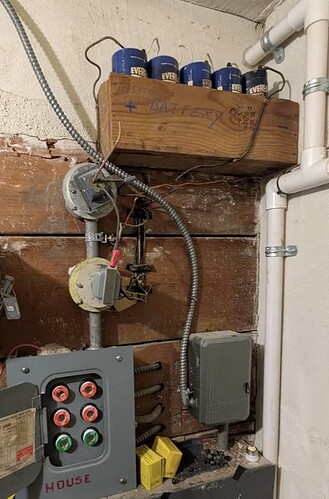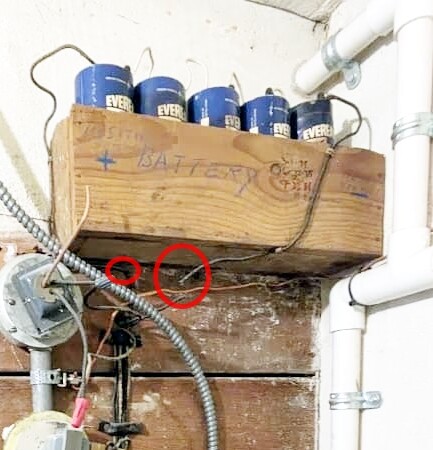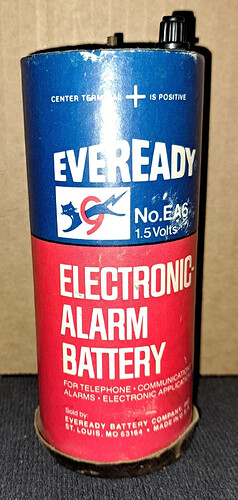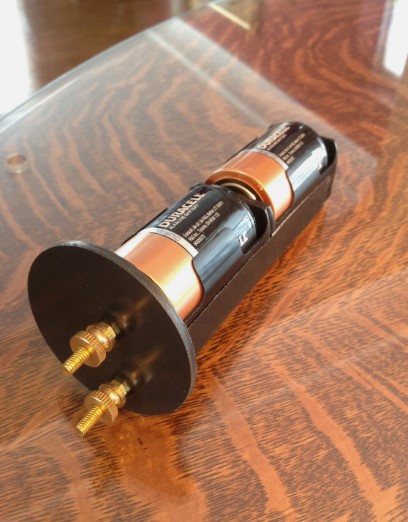Any idea what these batteries might have been for?
Was anything in that box under the batteries?
There are two transformers above the house fuse panel: the top one charges the batteries.
The metal bx cable runs a timer switch for common area lights.
The box just holds the batteries.
The neighboring building of similar era had the same batteries, just yellow.
Some kind of POTS phone connection or alarm power, maybe.
I count 10 x 1.5V Eveready batteries in series. 15V. Connected to step-down transformers.
Usual/normal/typical old doorbell voltage step-down transformer stepped down 120V AC household voltage to a low voltage of 8 to 16 volts AC.
No more ability to send current. Open Circuits.
Was Doorbell power, when needed, is my wag.
Applying an electrical current to an old time carbon / zinc battery is a worthless pursuit. It is not only ineffective (the chemical reaction is irreversible) it could possibly explode. In order to even begin answering the original question you’d have to know exactly what type of battery was being used.
For one, the batteries are not connected to high voltage.
They just go through the wall.
This is for the doorbell back in the 50’s.
Dependent on the population of Jehovah Witnesses and vacuum salesmen, they lasted for a year or more.
That many batteries for door bell only!!
probably used for a doorbell 7.5 Volts (connected in series), but could have been for an alarm of some kind…I remember using these 1.5 Volt batteries to power the glow plugs for our .049 engines on our Cox control line airplanes.
That’s right!
I forgot about the old .409 ![]()
![]()
Have you ever seen a 1950’s doorbell?
Low voltage was not very efficient yet.
Are you old enough to remember the 1st Cell Phones? ![]()
No high voltage in residential homes.
120V - volts for standard outlets and 240V - volts for large appliances, which is a low voltage classification; voltage below 1000V - volts.
No shitz Dick Tracy!
But guess what? Your statement is wrong from my perspective as a Thermographer.
However, some safety regulations may consider voltages as low as 50 or 600 volts to be high voltage depending on the context.
If you’re going to try and correct me over stupid interpretation, get it right!
Anything >600vac is considered “High Voltage” when inspecting electrical components. There is a whole bunch of required standards that must complied with above that voltage. For one, you need a Moon Suit to open a panel. The area must be set up for Blast Zone access and a bunch of other safety requirements.
When I get a call for an industrial inspection, I ask if they have any “High Voltage”. Every one of them knows it’s about >600vac.
Maybe you need to up your IR knowledge to Lvl III inspection.
Have you ever inspected 1,000vac?
May, Lol.
Yes. Right as usual.
They used to be connected to a doorbell-like transformer: you noticed the cut wires.
So the house power would charge the batteries.
In another building on the same street I found:
Morning Bryce. Hope to find you well and in good spirits today.
Thank you for your professional string that so many enjoy and count on.
Keep well.
Robert
It is chemically impossible for those dry cell batteries to be recharged. Explode maybe but recharge no.
Again, sorry you to my post negatively. That was not the intent.
Why yes. Many times, David. It was some time ago and to be clear, visually Inspect 1000 vac and components downstream, and not a comprehensive inspection or taking line measurements.
Just to clarify I would look and learn alot from George Wells.
Personally I do not think the batteries were charged. When exhausted the batteries were discarded.
French Battery and Carbon Company to Ray-O-Vac in 1934.
June 15, 1993, the French Rayovac announced its "reusable alkaline battery system. alkaline manganese (RAM) system.
Refillable #6 Rayco Ray-O-Vac dry cell… Positive and negative brass poles with knurled thumb nuts like the original batteries are powered by two modern D-cell batteries that are completely refillable .
Can’t recharge those Duracells either!







